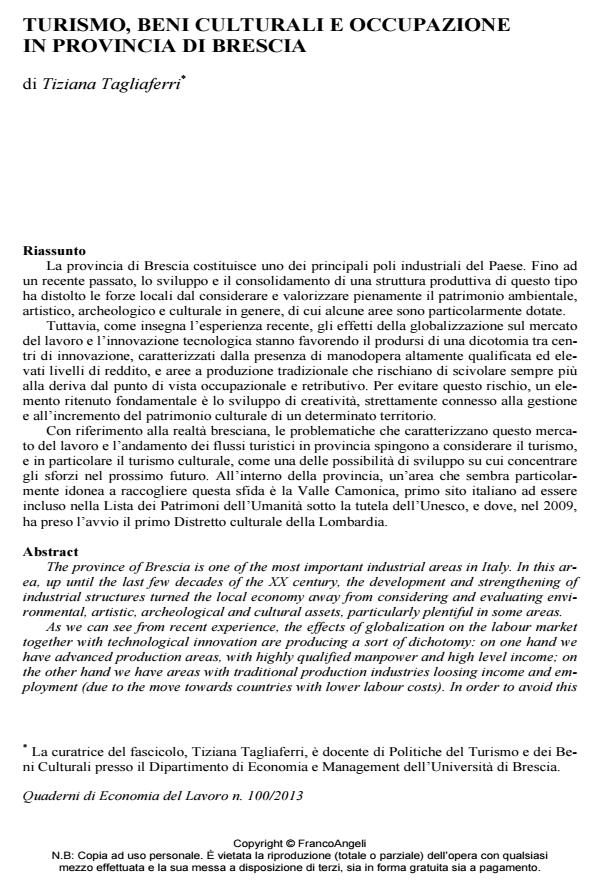Turismo, beni culturali e occupazione in provincia di Brescia
Titolo Rivista QUADERNI DI ECONOMIA DEL LAVORO
Autori/Curatori Tiziana Tagliaferri
Anno di pubblicazione 2013 Fascicolo 2013/100
Lingua Italiano Numero pagine 57 P. 21-77 Dimensione file 800 KB
DOI 10.3280/QUA2013-100003
Il DOI è il codice a barre della proprietà intellettuale: per saperne di più
clicca qui
Qui sotto puoi vedere in anteprima la prima pagina di questo articolo.
Se questo articolo ti interessa, lo puoi acquistare (e scaricare in formato pdf) seguendo le facili indicazioni per acquistare il download credit. Acquista Download Credits per scaricare questo Articolo in formato PDF

FrancoAngeli è membro della Publishers International Linking Association, Inc (PILA)associazione indipendente e non profit per facilitare (attraverso i servizi tecnologici implementati da CrossRef.org) l’accesso degli studiosi ai contenuti digitali nelle pubblicazioni professionali e scientifiche
La provincia di Brescia costituisce uno dei principali poli industriali del Paese. Fino adun recente passato, lo sviluppo e il consolidamento di una struttura produttiva di questo tipoha distolto le forze locali dal considerare e valorizzare pienamente il patrimonio ambientale,artistico, archeologico e culturale in genere, di cui alcune aree sono particolarmente dotate.Tuttavia, come insegna l’esperienza recente, gli effetti della globalizzazione sul mercatodel lavoro e l’innovazione tecnologica stanno favorendo il prodursi di una dicotomia tra centridi innovazione, caratterizzati dalla presenza di manodopera altamente qualificata ed elevatilivelli di reddito, e aree a produzione tradizionale che rischiano di scivolare sempre piùalla deriva dal punto di vista occupazionale e retributivo. Per evitare questo rischio, un elementoritenuto fondamentale è lo sviluppo di creatività, strettamente connesso alla gestionee all’incremento del patrimonio culturale di un determinato territorio.Con riferimento alla realtà bresciana, le problematiche che caratterizzano questo mercatodel lavoro e l’andamento dei flussi turistici in provincia spingono a considerare il turismo,e in particolare il turismo culturale, come una delle possibilità di sviluppo su cui concentraregli sforzi nel prossimo futuro. All’interno della provincia, un’area che sembra particolarmenteidonea a raccogliere questa sfida è la Valle Camonica, primo sito italiano ad essereincluso nella Lista dei Patrimoni dell’Umanità sotto la tutela dell’Unesco, e dove, nel 2009,ha preso l’avvio il primo Distretto culturale della Lombardia.
- Il turismo culturale come opportunità per il mercato del lavoro bresciano Tiziana Tagliaferri, in QUADERNI DI ECONOMIA DEL LAVORO 105/2017
DOI: 10.3280/QUA2016-105011 - Relationships between Heritage, Intangible Capital and Cultural and Creative Industries in Italy: A Framework Analysis for Urban Regeneration and Territorial Development Maria Immacolata Simeon, Assunta Martone, in Advanced Engineering Forum /2014 pp.149
DOI: 10.4028/www.scientific.net/AEF.11.149
Tiziana Tagliaferri, Turismo, beni culturali e occupazione in provincia di Brescia in "QUADERNI DI ECONOMIA DEL LAVORO" 100/2013, pp 21-77, DOI: 10.3280/QUA2013-100003